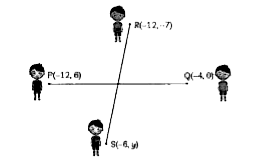Case Study-1: Some friends of class X goes to picnic at waterpark. There were slides i.e. water coaster, aqua loop and launch chamber slide.
The graph below shows the position of these 3 slides by point P, Q and R.

Find the length of P and Q.
√3
√4
√5
√6
The correct Answer is:C
Step by step video, text & image solution for Case Study-1: Some friends of class X goes to picnic at waterpark. There were slides i.e. water coaster, aqua loop and launch chamber slide. The graph below shows the position of these 3 slides by point P, Q and R. Find the length of P and Q. by Maths experts to help you in doubts & scoring excellent marks in Class 10 exams.
Updated on:21/07/2023Topper's Solved these Questions
Similar Questions
Through the point p (3, -5), a line is drawn inclined at 45 with the positive direction of x-axis. It meets the line x+y−6=0 at the point Q. Find the length of PQ.
View SolutionIn comparing the resistance of two cells PandQ with a sides wire bridge, a balance point is obtained when the sliding contact is 30cm from the zero end of the wire. The resistances PandQ are interchanged and the balance is obtained at 120cm from the same emf. Find the ratio of the resistance PandQ and the length of the bridge wire
View Solution
Knowledge Check
A point E with x-coordinate 4 lies on the line segment joining the point P(2,−3,4) and Q(8,0,10). Find the coordinates of the point R
A(4,−2,−6)B(4, 2, 6)C(4,−2,6)DNone of the theseAn electric dipole is the combination of two equal and opposite charges q and -q, respectively, separated by distance 2a. There are different points where we can find electric field due to the electric dipole. In the given table, column 1 shows different positions of point where we have to find electric field due to dipole, column 2 shows the figure of dipole with different positions of point where we have to find the electric field and column 3 shows the value or final formula of the electric field of different positions of the point.
When point P lies on the equatorial plan of the electric dipole, electric field due to -q is ?

 A(I) (i) (J)B(I) (i) (M)C(III)(iii) (J)D(I) (i) (K)
A(I) (i) (J)B(I) (i) (M)C(III)(iii) (J)D(I) (i) (K)An electric dipole is the combination of two equal and opposite charges q and -q, respectively, separated by distance 2a. There are different points where we can find electric field due to the electric dipole. In the given table, column 1 shows different positions of point where we have to find electric field due to dipole, column 2 shows the figure of dipole with different positions of point where we have to find the electric field and column 3 shows the value or final formula of the electric field of different positions of the point.
when point P lies on the equatorial plane of the electric dipole, electric field due to +q is ?

 A(III) (ii) (L)B(IV) (i) (M)C(III) (iii) (J)D(I) (i) (M)
A(III) (ii) (L)B(IV) (i) (M)C(III) (iii) (J)D(I) (i) (M)
Case Study-1
Four friends visited a nearby park to plya. They decided to play with the ball. So they get stood the four corners P, Q, R, S of the rectangulor park PQRS and started playing pass the ball.

If A is the mid-point of P and Q, then find the coordinates of A.
View SolutionIn a meter-bridge experiment, two resistances P and Q are connected in series in the left gap. When the resistance in the right gap is 50Ω, the balance point is at at the centre of the slide wire. If P and Q are connected in parallel in the left gap, the resistance in the right gap has to be changed to 120Ω so as to obtain the balance point at the same position. find P and Q.
View SolutionAs shown in the figure, a cube of mass m starts from rest from point 1 at a height 4R, where R is the radius of the circular track. The cube slides down the frictionless track and goes around the loop as shown. The force which the track exerts on the cube at point. 2 is βmg. Find β.
'(##CEN_KSR_PHY_JEE_C07_005_Q03##)'
View SolutionCase Study-1
Four friends visited a nearby park to play. They decided to play with the ball. So they get stood the four corners P, Q, R, S of the rectangular park PQRS and started playing pass the ball.

Calculate the total distance between the points P and Q
View SolutionAn electric dipole is the combination of two equal and opposite charges q and -q, respectively, separated by distance 2a. There are different points where we can find electric field due to the electric dipole. In the given table, column 1 shows different positions of point where we have to find electric field due to dipole, column 2 shows the figure of dipole with different positions of point where we have to find the electric field and column 3 shows the value or final formula of the electric field of different positions of the point.
When point P lies on the axis of the electric dipole, electric field due to -q is ?


View Solution
